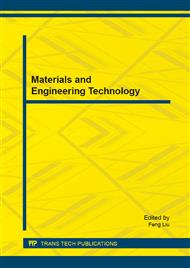[1]
ISO/IEC 10918-1 and ITU-T Recommendation T. 81, Information technology- Digital compression and coding of continuous-tone still images: Requirements and guidelines, (1994).
Google Scholar
[2]
T. Wiegand, G. J. Sullivan, G. Bjontegaard, and A. Luthra, Overview of the H. 264/AVC video coding standard, IEEE Trans. Circuits Syst. Video Technol., vol. 13, pp.560-576, (2003).
DOI: 10.1109/tcsvt.2003.815165
Google Scholar
[3]
Y. L. Lee, K. H. Han, D. G. Sim, and J. Seo, Adaptive scanning for H. 264/AVC intra coding, ETRI Journal, vol. 28, no. 5, pp.694-696, Oct. (2006).
DOI: 10.4218/etrij.06.0206.0095
Google Scholar
[4]
H. H. Chen, Y. W. Huang, and J. J. Ding, Local Prediction based adaptive scanning for JEPG and H264/AVC inter coding, ICIP , pp.1636-1640, Oct. (2013).
Google Scholar
[5]
Q. C. Sun, X. Y. Wu, and L. Yu, An adaptive coefficient scanning scheme for inter-prediction coding, Picture Coding Symposium, Nov. (2007).
Google Scholar
[6]
W. Thomas, S. Berbhard, and K. Satoshi, Adaptive scan order of DCT coefficients and its signaling, European Patent-EP 1 768 415 A1, (2005).
Google Scholar
[7]
J. J Ding, W. Y. Wei, and H. H. Chen, Context-based adaptive zigzag scanning for image coding, Visual Communications and Image Processing, pp.1-4, Nov. (2011).
DOI: 10.1109/vcip.2011.6115900
Google Scholar
[8]
X. Fan, Y. Lu, and W. Gao, A novel coefficient scanning scheme for directional spatial prediction-based image compression, IEEE International Conference on Multimedia and Expo, pp.557-560, vol. 2 , Jul. (2003).
DOI: 10.1109/icme.2003.1221677
Google Scholar
[9]
Y. J. Yoo, S. Jeong, J. K. Han, Adaptive scan pattern forquantized coefficients in intra coding of H. 264, IEICE Trans. Inf. and Syst., vol. E92-D, no. 4, pp.750-752, Apr. (2009).
DOI: 10.1587/transinf.e92.d.750
Google Scholar
[10]
Z. Gu, W. Lin, and B.S. Lee, Mode-dependent templates and scan order for intra lossless coding, IEEE Transactions on Image Processing, vl. 21, no. 9, pp.4106-4117, Sep. (2012).
DOI: 10.1109/tip.2012.2197630
Google Scholar
[11]
B. Zeng and J. -J. Fu, Directional discrete cosine transforms – a new framework for image coding, IEEE Trans. Circ. Syst. For Video Technology, pp.305-313, Mar. (2008).
DOI: 10.1109/tcsvt.2008.918455
Google Scholar
[12]
J. Xu, B. Zeng and F. Wu, Overview of directional transform in image coding, ISCAS, pp.3036-3039, (2010).
Google Scholar


